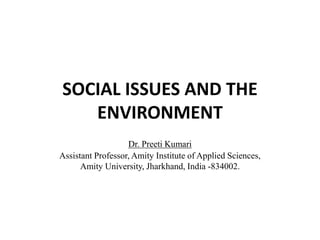The document discusses the intersection of social issues and environmental concerns, focusing on energy consumption, water conservation, and the challenges of urbanization. It highlights the increasing demand for energy, the environmental impact of fossil fuels, and the need for sustainable energy practices, as well as the critical situation regarding water availability due to climate change and urban growth. Additionally, it addresses the challenges of resettlement and rehabilitation due to development projects, urging for ethical resource management and effective conservation strategies.











































![AIR (PREVENTION AND CONTROL OF
POLLUTION) ACT
• This act was enacted by the Parliament under Article 253 of the constitution of
India to implement decisions of 1972 Stockholm conference on human
environment and it came into force in 1981 as Air
(Prevention and Control of Pollution) Act,1981.
This is an act to provide for the prevention, control and abatement of air pollution.
The main objectives of the Act are as follows:
• To provide for the Prevention, Control and abatement of air pollution. In this Act
the term
“air pollutant” means any solid, liquid or gaseous substance [including noise]
present in the
atmosphere in such concentration and tend to be injurious to human beings or
other living
creatures or plants or property or environment.
• The establishment of Central and State Boards with a view to implement the Act,
and to
confer on the Boards the powers to implement the provisions of the Act.
• Set up of Pollution Control Boards (PCBs) to measure pollution levels in the
atmosphere.](https://image.slidesharecdn.com/socialissues-231230050916-7d1b7b67/85/Social-Issues-pptx-44-320.jpg)












